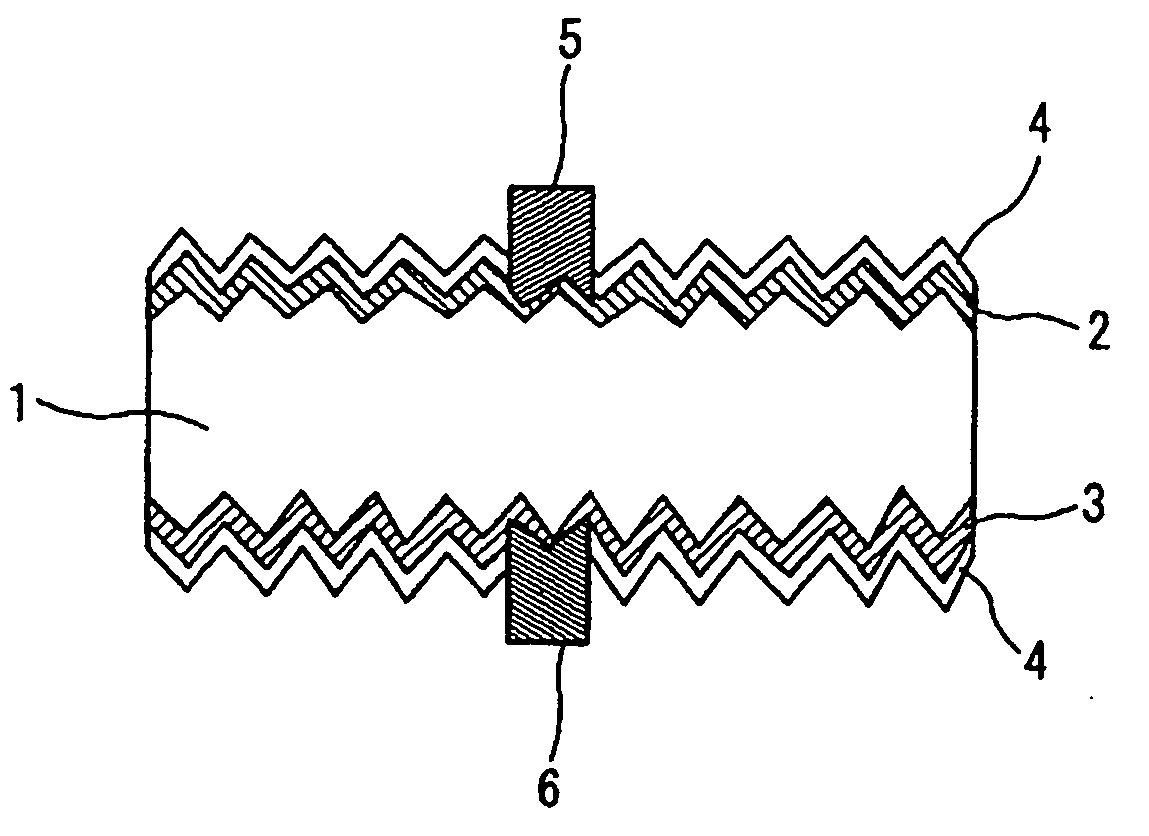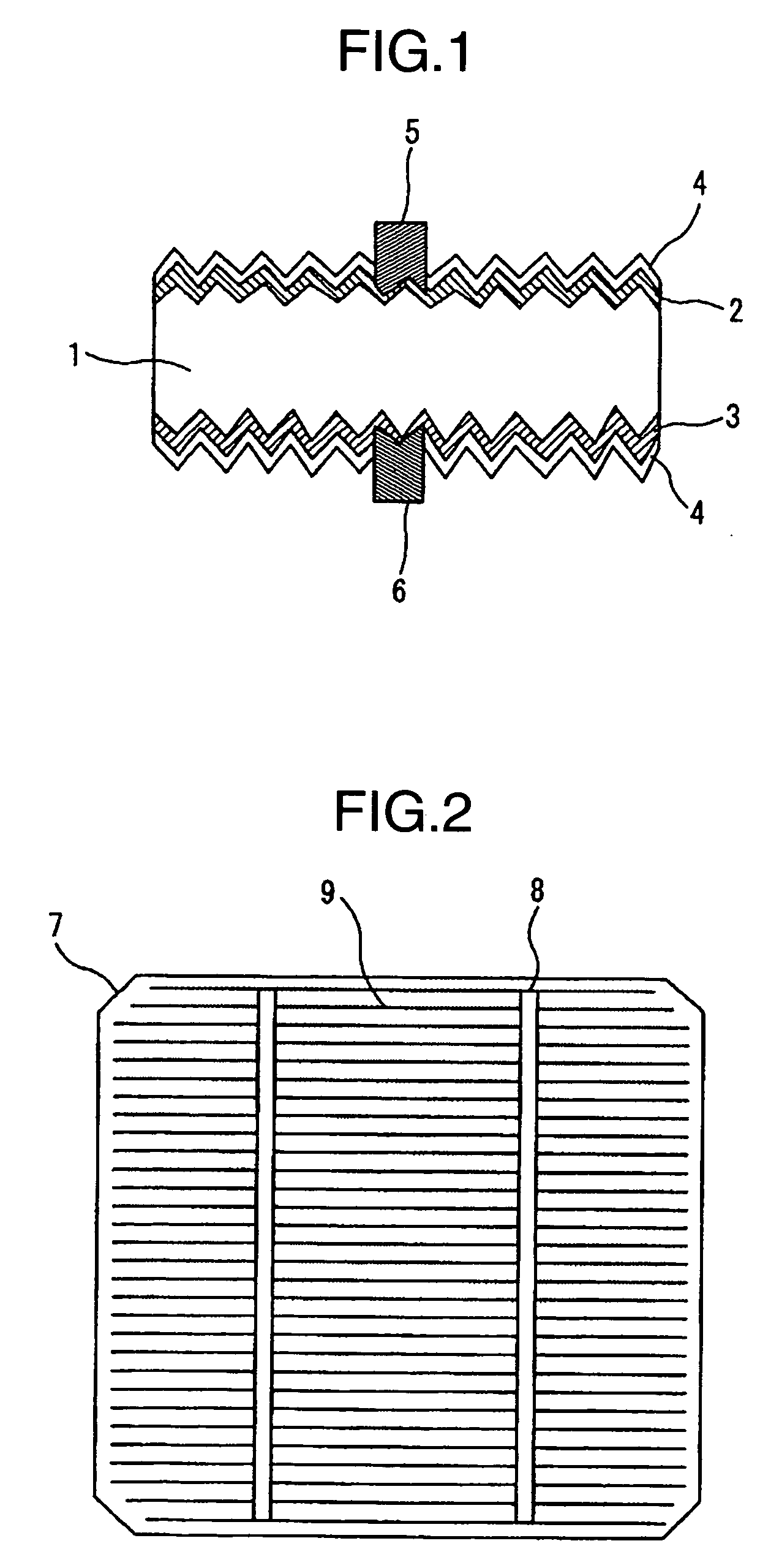Silicon solar cell and production method thereof
- Summary
- Abstract
- Description
- Claims
- Application Information
AI Technical Summary
Benefits of technology
Problems solved by technology
Method used
Image
Examples
example 1
[0032]FIG. 1 illustrates a cross-sectional structure of the solar cell produced in Example 1, where the silicon substrate 1 may be of p- or n-type. The solar cell is described here taking a p-type substrate as an example.
[0033] The solar cell of Example 1 comprises the silicon substrate 1 coated with the n+ layer 2 on the front side and p+ layer 3 on the back side, the former being formed by phosphorus diffusion and the latter by boron diffusion, where the n+ layer 2 and p layer of the silicon substrate 1 form the p-n junction while the p+ layer 3 forms a BSF. Each of the n+ layer 2 and p+ layer 3 is coated with the silicon oxide (SiO2) film 4.
[0034] The n+pp+-diffused substrate of BSF structure is coated with the respective front electrode 5 as the cathode on the front side and back electrode 6 as the anode on the back side. The grid-shape electrode for the silicon solar cell of Example 1 is composed of the busbar electrodes 8 and finger electrodes 9, as illustrated in FIG. 2, wh...
example 2
[0046] The solar cell with n+pp+ BSF structure was produced in Example 2 in the same manner as in Example 1, except that it was coated with the grid-shape electrode, as illustrated in FIG. 2, on the front side, not expecting positive photosensitivity on the back side. Therefore, it differs from the cell produced in Example 2 only in that the electrode accounts for a larger area and is arranged more finely and tightly as shown at FIG. 5. In other words, area ratio of the grid-shape electrode on the front side to the front side surface is smaller than that of the grid-shape electrode on the back side to the back side surface.
[0047] A mono-facial cell by conventional technique, illustrated in FIG. 6, comprises the n+p-diffused substrate 12 coated with the aluminum electrode 13 of uneven brownish red color over the entire back side. By contrast, the mono-facial cell of Example 2, illustrated in FIG. 5, comprises the n+pp+-diffused substrate 7 coated with the busbar electrodes 8 and fin...
example 3
[0049] The solar cell was produced in the same manner as in Example 1 or 2, except that the fine finger electrodes 9 (width: 100 μm or less) were made thicker at the bases 11 on the busbar electrode 8, as illustrated in FIG. 7. The width of the busbar electrode 8 in the cell of Example 3 is at least 10 times wider than that of the finger electrode 9 and is 1 to 3 mm. The wider base 11 is rectangular (FIG. 7 (A)) or triangular (FIG. 7(B)), and the finger electrodes 9 are made 2 to 4 times wider in width at a portion around 1 mm from the base 11. The width of the finger electrode 9 may be made wider in the section from the base 11 to 0.3 to 2 times of the busbar electrode width. The solar cell of Example 3 has improved cell performance, because the finger electrodes 9 for the grid-shape electrode are made finer to increase number of the finger electrodes 9 and thereby to reduce series resistance of the cell.
[0050] As discussed above, Example 3 realizes a solar cell of high efficiency...
PUM
 Login to View More
Login to View More Abstract
Description
Claims
Application Information
 Login to View More
Login to View More - R&D
- Intellectual Property
- Life Sciences
- Materials
- Tech Scout
- Unparalleled Data Quality
- Higher Quality Content
- 60% Fewer Hallucinations
Browse by: Latest US Patents, China's latest patents, Technical Efficacy Thesaurus, Application Domain, Technology Topic, Popular Technical Reports.
© 2025 PatSnap. All rights reserved.Legal|Privacy policy|Modern Slavery Act Transparency Statement|Sitemap|About US| Contact US: help@patsnap.com



